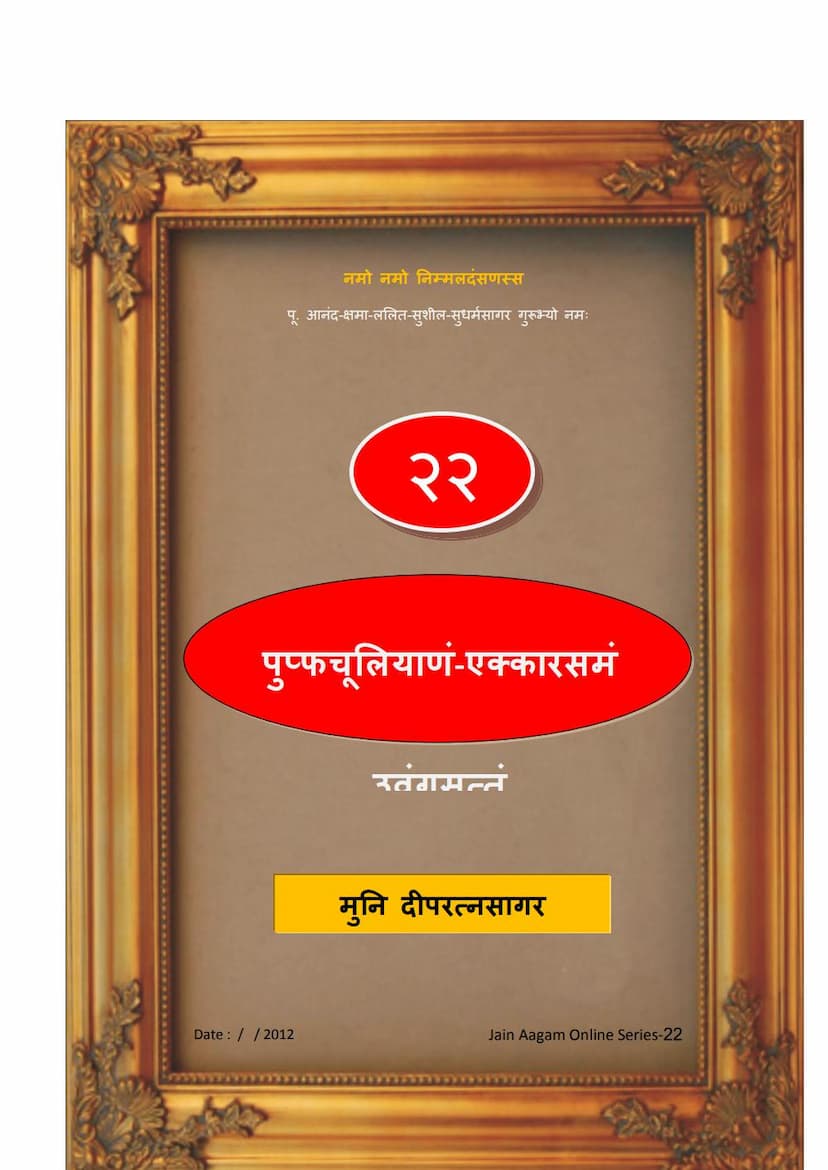Agam 22 Puffachuliyanam Ekkarasam Uvvangsuttam Mulam PDF File
Added to library: September 1, 2025

Summary
Here's a comprehensive summary of the provided Jain text, focusing on its content and key elements, based on the pages you've shared:
Book Title: Agam 22 Puffachuliyanam Ekkarasam Uvvangsuttam Mulam PDF File Author(s): Dipratnasagar, Deepratnasagar Publisher: Deepratnasagar Catalog link: https://jainqq.org/explore/003743/1 Context: Jain Education International, for private and personal use only.
This document is part of the Jain Agam Online Series, specifically volume 22, focusing on the "Puffachuliyanam Ekkarasam Uvvangsuttam." The text is presented as a compilation or commentary by Muni Diperatnasagar, revised and edited by him.
Overall Structure and Content:
The document appears to be a section from a larger Jain scripture. It begins with a table of contents (Ganthānukkamo) listing the chapters (Adhyayana) and their respective verses (Gaha). It indicates that this section, "Puffachuliyanam," is the eleventh part of the Upanga Sutra.
The core of the provided text (Pages 3-5) details the first chapter (Adhyayana-1) of the "Puffachuliyanam." This chapter focuses on the story of a woman named Bhuta and her journey towards spiritual renunciation.
Key Points and Narrative:
- Chapter Structure: The text establishes that the "Puffachuliyanam" has ten chapters in total, and the first chapter is being presented.
- The Story of Bhuta:
- The narrative begins by setting the scene in Rajagriha city during the time of Lord Mahavira.
- Bhuta is introduced as the beloved daughter of a wealthy householder named Sudarshana and his wife Soma. She is described as unmarried and possessing all the qualities of a virtuous young woman.
- Bhuta hears the teachings of the Arhat Pārśva (Pāse Araha) and is deeply impressed.
- Seeking permission from her parents, she goes to meet Pārśva.
- After listening to the Dharma, she expresses her desire to renounce the worldly life and become a nun (pravrajyā).
- Her parents consent, and she takes initiation (diksha) from Pārśva.
- Bhuta's Spiritual Journey and Subsequent Life:
- After her initiation, Bhuta becomes known as Arya Bhuta.
- She develops an obsessive habit of washing her hands, feet, head, mouth, and other parts of her body. She also exhibits excessive cleanliness regarding her seating and sleeping arrangements.
- Her fellow nuns, the Pūṣpakulā (Puffachulā) nuns, notice her excessive behavior and advise her to atone for it.
- However, Arya Bhuta continues her obsessive cleaning.
- She undertakes severe austerities, including fasts and other rigorous penances, for many years.
- Despite her prolonged spiritual practice, she does not atone for her obsessive behavior.
- Rebirth and Destiny:
- As a result of her actions, after her death, she is reborn in the Śukra heaven (Sohamma Kappa), specifically in the Śrīvratansa Vimana, as Śrīdevi (Siridevi).
- The text states her lifespan in that celestial realm is one palya (a vast unit of time).
- When her lifespan ends, she will achieve liberation (siddha) in Videha country.
- Generalization: The text concludes by stating that the same narrative of rebirth and eventual liberation applies to the other nine nuns who were initiated along with Bhuta. They all became Śrīdevi in the Śukra heaven and will eventually attain salvation in Videha.
Key Jain Concepts Mentioned or Implied:
- Agam: Refers to the scriptures of Jainism.
- Upanga Sutra: A category of secondary Jain scriptures.
- Arhat: A venerable or accomplished being who has attained omniscience.
- Dharma: The path of righteousness, spiritual duty.
- Diksha (Pravrajyā): Religious initiation or renunciation.
- Nuns (Samaṇī, Nirgranthī): Female ascetics in Jainism.
- Tapas (Asceticism): Austerities and penances undertaken for spiritual purification.
- Karma: The law of action and reaction that determines one's rebirth and destiny.
- Rebirth (Chavan, Upapāda): The cycle of death and reincarnation.
- Liberation (Siddhi): The ultimate goal of Jainism, freedom from the cycle of birth and death.
- Heavenly Realms (Devaloka): Celestial abodes where beings are reborn based on their good karma.
- Vimana: A celestial palace or dwelling.
- Atonement (Pratikramana/Aaloehi): The act of confessing and repenting for one's sins.
- Eriya Samiti: One of the five vows of Jain ascetics, related to careful movement.
- Gupta Brahmacharya: Celibacy.
Significance of the Text:
This excerpt from the "Puffachuliyanam" appears to illustrate the Jain principles of karma and rebirth. It shows how even a spiritual practitioner's actions, particularly those stemming from obsessive tendencies (like excessive cleanliness), can lead to a specific type of rebirth, even if they ultimately achieve liberation. The story emphasizes the importance of right conduct and avoiding excessive attachment or obsessions, even in spiritual practice. It also highlights the veneration of Pārśva and the lineage of female ascetics in Jainism.
The meticulous editing and presentation by Muni Diperatnasagar suggest an effort to make these important Jain texts accessible and understood.